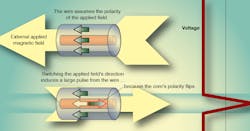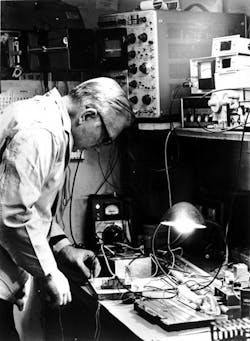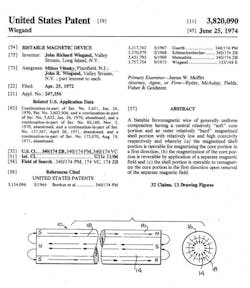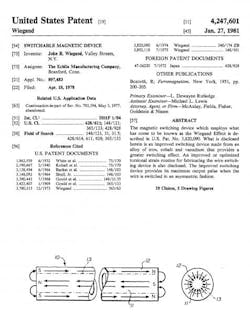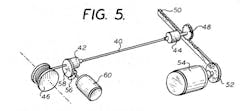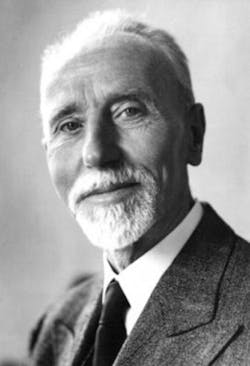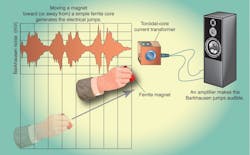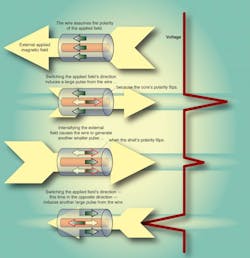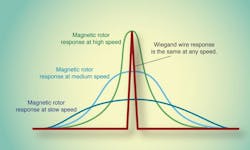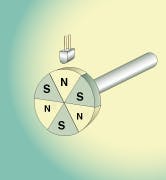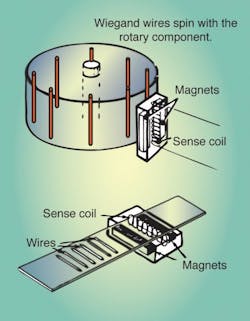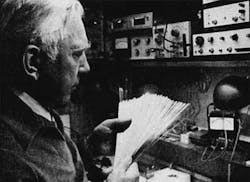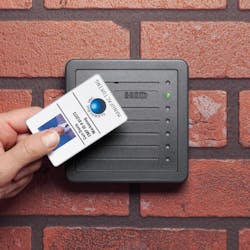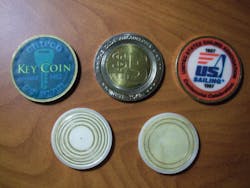Brushing Up on Wiegand: The man, the effect, and the wire that changed engineering
The Wiegand effect, a phenomenon discovered in the 1970s, is the unusually useful behavior of magnetic fields in specially designed wire that outputs voltage.
External fields easily magnetize the outer shell, which also resists demagnetization, even when external fields are removed — a characteristic called higher coercivity. The soft wire filling behaves differently: It's not magnetized until after the shell gets its fill of magnetization.
Herein lies the magic: At the very moment that the wire's shell becomes fully magnetized, and the core is finally allowed to collect its own portion of magnetization, poof — both core and shell switch polarity. The switch generates significant voltage that can be harnessed for all kinds of sensing and motion applications.
John R. Wiegand: The man
John Wiegand, inventor of his namesake wire was neither engineer nor physicist, but a musician by training. Born in Germany in 1912, Wiegand came to the U.S. in the 1930s and studied piano and choral conducting at the Juilliard School of Music, New York.
There, he became interested in audio amplifiers — and later, became an engineering assistant for magnetic amplifiers at the Bell Telephone Laboratory. In 1944, he began work for Sperry Gyroscope Company in Lake Success, N.Y., and then for a government contractor as a product developer of tape recorders.
In 1965, after becoming an electronics technician at Echlin Mfg. Corp., Branford, Conn., Wiegand began the relentless pursuit of magnetic research that led to his terrific discovery: Seven years later, on June 25, 1974, his bistable ferromagnetic wire was patented.
Before he had an oscilloscope to see pulses, it was Wiegand's perfect pitch that enabled him to listen through a loudspeaker to the magnetic pulses produced by his wire. John always referred to each wire as “she” and said that the wires sung to him.
Wiegand later met Milton Velinsky and together they formed Wiegand Electronics to develop product applications for the Wiegand Effect. Wiegand did the inventing and Velinsky did the promoting and selling.
How Wiegand wire is made
Ferromagnetic Vicalloy wire (made of cobalt, iron, and vanadium) is twisted and untwisted during increasingly aggressive coldworking under tension. Then the wire is hardened to hold its crystalline structure.
Then when Wiegand wire is put in an application — say, placed in a zone subject to alternating longitudinal magnetic fields — the wire forms a hysteresis loop ... and wire shell and wire core polarity switches cause large Barkhausen discontinuities.
The output (when Wiegand wire is used in a sensor application, for example) the amplitude of a typical Wiegand pulse depends on the setup — so is somewhat independent of excitation field strength and orientation. That said, pulse width generally remains constant: Magnetic switching of Wiegand wire induces voltage across pickup coils lasting about 10 µsec.
Why the sudden change? Barkhausen, that's why
Wiegand wire’s sudden polarity flip is due in part to iron’s tendency to magnetize in little steps rather than in a smooth progression. When subjected to an external field, microscopic “neighborhoods” of similarly oriented atoms snap into alignment together, and then cause nearby neighborhoods to do the same. Physicist Heinrich Barkhausen (pictured to the right) discovered this phenomenon in 1919.
Pulses, switching, and magnetization
Once Wiegand wire flips magnetization, it retains that magnetization until flipped again. Mechanisms and sensors utilizing the Wiegand effect must accommodate this retention.
In symmetric switching, alternating positive and negative magnetic fields of equal strength trigger the Wiegand wire. First, a saturating magnetic field aligns the core and shell polarities. Magnet movement causes replacement of this field with an opposite field of equal strength.As the field intensifies, the Wiegand wire core switches polarity, and outputs a large voltage pulse. As the field strengthens further, the Wiegand-wire shell follows suit and also switches polarity — producing a smaller pulse of the same polarity (often miniscule on oscilloscopes compared to the pulse associated with the core's switch.)
Finally, when this magnetic field fully saturates the Wiegand wire, reverts to its original polarity, and intensifies in that direction, it causes the opposite core (and then shell) to switch.
Symmetric switching of Wiegand wire is most common, because it is easiest to produce with permanent magnets. In asymmetrical switching, Wiegand wire is magnetized and triggered by magnetic fields of opposite polarity but unequal strength.
Wiegand applications
The Wiegand effect is used for myriad applications. The alternating positive and negative magnetic fields that magnetize and trigger the wire are produced in three ways:
1. By magnets affixed to rotating or moving equipment (paired with stationary Wiegand-wire pickups)
2. Moving Wiegand wires (paired with stationary read heads), or
3. AC-generated fields (paired with Wiegand wires in varied setups).
In rotational counting pulsers, a short piece of Wiegand wire is installed inside a stationary pickup coil with magnetic-field concentrators. A spinning permanent-magnet wheel turns near the pickup. Depending on which magnetic pole (north or south) triggers the sensor, positive or negative voltage pulses are produced. The air gap between the pickup sensor and magnet can be as much as 1 in., depending on magnet strength. Output is typically a 10-µsec pulse of 5 to 6 V into a load of 24,000 Ω. A variety of magnets can be used, from simple bar types to multipole ring magnets.
In addition, if two pickups are used, then the setup can also report rotational direction.
Another rotary-pulser design uses a stationary magnetic read head. Here, multiple Wiegand wires — embedded in a drum — rotate through the fixed magnetic field. The airgap between the two is about 0.050 in. In addition, sensor output is a 10-µsec pulse of about 2 V into a 24,000-Ω load — for a lower voltage pulse than the other magnet-actuated sensor design. Why? In this setup, the pickup coil is in the read head and not wound around the Wiegand wire. However, this sensor can indicate rotational direction: In one direction, it produces positive pulses, and in the other, negative.
In a linear variation of this design, pieces of Wiegand wire are laid in strips on a moving plank that passes a read head — to produce positive pulses in one direction of motion, and negative in the other.
Besides permanent magnets, ac-generated electromagnetic fields can also trigger Wiegand wire. Sometimes a coil is simply wound around a Wiegand sensor and ac current applied. More elaborate designs utilize an electromagnet to trigger the sensor.
Keycards: For security door locks, a card reader produces a fixed magnetic field, and users pull their Wiegand-wire cards through it. Wires are arranged in two tracks; one track contains the binary “0” data and the other track contains the binary “1” data. As the magnetic field flips at each wire, it outputs a 0 or 1 in a serial self-clocking scheme. The digital data then travels to a host controller that determines whether to electrically unlock the door. The format of this data stream is called the Wiegand Protocol, named after John Wiegand, and is still widely used in the security industry.
These are then used to power a Hall-effect sensor (to detect rotation direction) and an electronic counter that increments or decrements the number of rotations recorded in controller memory.
In contrast with inexpensive dynamos (in which the voltage produced depends on turning speed), the Wiegand-effect counter creates sharp electric pulses independent of the magnetic field rate of change, so that pulse strength is effectively the same for all shaft rpms. Operation without external power means that absolute shaft position is registered even during shutdowns and power outages.
Coins not easily counterfeited
Though this exotic application isn't in wide use, Wiegand wires have been implanted in some specialty vending and casino-chip tokens, which are then read by using the Wiegand-effect sensors when the coins are dropped into a slot.
The Wiegand wires communicate authenticity and value; their circular placement in each coin guarantees that it will be read, no matter the orientation.
Michael L. Davis is the Director of Intellectual Property at HID Global. He has numerous patents; has worked with the SIA standards group on Access Control Standards; was HID Global's representative on the M1 Biometrics ISO committee; and holds a M.S. in Computer Science and a B.S. in Medical Computer Science.
Davis is writing a book on John Wiegand and the Wiegand effect.
About the editor: Elisabeth Eitel uses a keycard containing Wiegand wires every day to enter the offices of Machine Design.
For more information, visit hidglobal.com and search Wiegand or Davis. Otherwise, direct technical questions to the author at [email protected].
